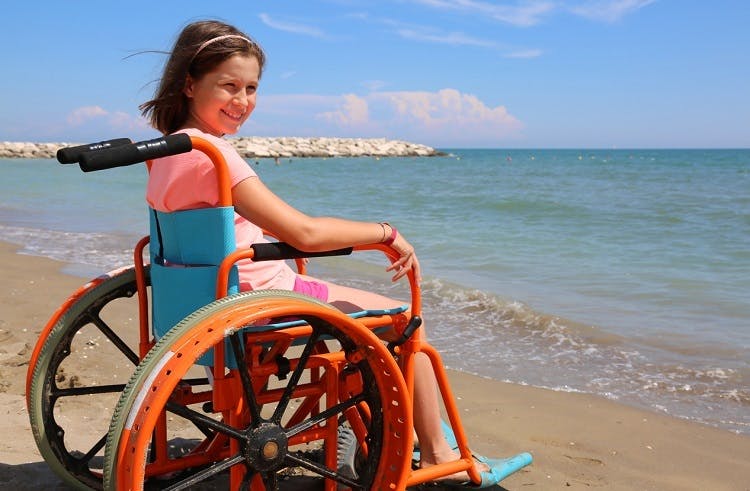No products in the cart.
No products in the cart.
No products in the cart.
No products in the cart.
Home » Neurological Recovery Blog » Cerebral Palsy » Does Cerebral Palsy Affect Body Temperature Regulation?
Last updated on February 16, 2021

Many children with cerebral palsy experience problems with body temperature regulation.
Changes in the weather, limited mobility, and brain damage can result in irregular thermoregulation.
In this article, we’ll go over how cerebral palsy affects body temperature regulation and share some tips for cooling down or warming up.
While anyone can be affected by extreme temperatures, individuals with cerebral palsy are more likely to experience negative symptoms due to limitations in movement and communication.
In this study of 374 children with cerebral palsy, 30% of parents reported that their child had body temperature regulation problems.
Let’s go over a few factors that may be responsible for poor body temperature regulation in cerebral palsy patients:
The autonomic nervous system regulates involuntary functions like body temperature, blood pressure, heart rate, and digestion.
Cerebral palsy is caused by damage to the brain before or during birth, or in early childhood.
The severity of one’s cerebral palsy is correlated to the amount of brain damage they have. Therefore, those with more severe CP have greater brain damage.
If the hypothalamus (the region of the brain responsible for regulating the autonomic nervous system) is damaged, an individual with cerebral palsy may experience autonomic dysfunction and have poor body temperature regulation.

Movement is important for body temperature regulation. Movement increases blood circulation, as muscles generally require oxygen carried by the bloodstream to create energy to move. Muscle contractions also stimulate the return of blood to the heart.
Areas of the body that aren’t being moved will therefore have reduced circulation. Since warm blood is not circulating as well through areas that are not moving, these areas get colder.
In addition, when muscles contract, they produce heat. When muscles have limited mobility, they are unable to produce as much heat to help with temperature regulation. This explains why children with cerebral palsy who cannot walk often have lower temperatures in their hands and feet than those who can walk.
Furthermore, because individuals with cerebral palsy have limited mobility and may not be able to generate as much heat from muscle contractions, they get cold more easily.
Cerebral palsy patients are also more likely to overheat and fatigue quicker because their bodies have to work harder and use up to 3 times more energy to move.
Want 19 pages of CP recovery tips in PDF form? Click here to download our free illustrated ebook now (link opens a pop up for uninterrupted reading)
When you have difficulties regulating body temperature, it’s essential to be mindful of the weather.
The bodies of individuals with cerebral palsy are much more vulnerable to extreme outside temperatures.
Cold weather can cause the muscles to tense up and increase involuntary movements.
Hot weather may help relax tight muscles, but it can also make it a lot easier for individuals with CP to get overheated and dehydrated.

Unlike people without mobility limitations, someone with cerebral palsy may not be able to independently leave a room, put on or take off a layer of clothing, or get a glass of water. They also may not be able to wiggle their toes or rub their hands together to warm up their feet or hands.
Additionally, individuals who have difficulties communicating due to cerebral palsy may not be able to ask for the heat to be turned up or a fan to be turned on.
Since individuals with cerebral palsy may not be able to independently thermoregulate, caregivers should keep a close eye out for signs of being too hot or too cold.
Signs of hypothermia (being too cold) include:
Signs of hyperthermia (overheating) include:

While poor body temperature regulation can’t be cured, individuals with cerebral palsy can improve their quality of life by being prepared.
Understanding what to do when you’re overheating or are too cold is crucial. Here are some tips for combating extreme temperatures:
Tips for Cooling Down:
Tips for Warming Up:
Problems with body temperature regulation are common in cerebral palsy patients, so it’s important to be prepared.
Not all individuals with cerebral palsy will have neurologically impaired thermoregulation, but they will be more vulnerable to feeling cold or overheating because of their motor impairments.
That’s a wrap! Hopefully, this article helped you understand why your loved one with cerebral palsy feels hot or cold so easily.

Get our free 19-page PDF full of helpful tips for cerebral palsy by signing up below! If you liked this article, you’ll LOVE our free ebook.
When you sign up, you’ll also receive our popular emails that share more tips for life with cerebral palsy — you can opt out anytime.
We will never sell your email address, and we never spam. That we promise.


At Flint Rehab, we understand that doing physical therapy at home can become tedious and repetitive. But when repetition is critical to recovery, it’s important to stick with a repetitive regimen. But that doesn’t mean it has to be boring.
Flint Rehab is the leading manufacturer of motion-sensing, gamified rehabilitation devices. Our bestselling recovery tool, FitMi, transforms full-body rehab exercises into an interactive experience.
See what individuals with CP are saying about FitMi:
“The FitMi and MusicGlove have done wonders for my son with hemiparesis from cerebral palsy and stroke. It motivates him to do his exercises. It does not seem like therapy for him since it is fun. FitMi monitors his progress so it is a great reinforcement for him. Music is a motivator for him. He has been using it on his arm and we will try the leg exercises soon.”
-Manning
While FitMi is a recovery tool for the full-body, our other device, MusicGlove, helps target the hand to improve fine motor skills and dexterity.
See what others have said about MusicGlove:
“My granddaughter has right-side hemiplegia from Cerebral Palsy / stroke at birth. She states that this is a great product for anyone who has issues with the use of their hand(s), and that is has helped her tremendously. She also finds the music quite catchy (surprisingly!). Our occupational therapist has been impressed as well. I can say that it has arguably been the best tool of all our therapy resources.”
-Jenni
Together, FitMi and MusicGlove make a powerful home therapy regimen for individuals with cerebral palsy. Best of all, you can save money when you bundle them together.
To learn more, click the button below:

Do you have these 19 pages of helpful tips for CP?
Get a free copy of our ebook Helpful Tips for Managing Cerebral Palsy. Click here to get instant access.
Grab a free rehab exercise ebook!
Sign up to receive a free PDF ebook with recovery exercises for stroke, traumatic brain injury, or spinal cord injury below: